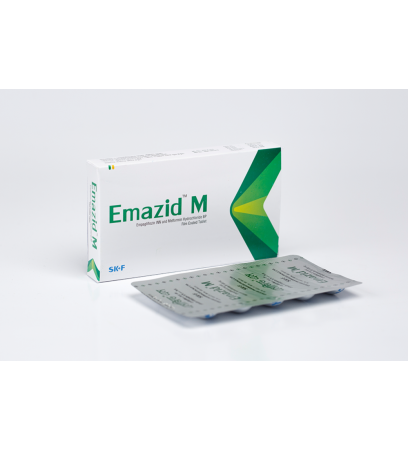Emazid M Tablet 5 mg+500 mg
- Brand:Eskayef Pharmaceuticals Ltd
- Product Code: Empagliflozin + Metformin Hydrochloride
- Availability: In Stock
-
15.00Tk.
This product has a minimum quantity of 10
Indications
This tablet is indicated for the treatment of adults with type 2 diabetes mellitus as an adjunct to diet and exercise:
- In patients insufficiently controlled on their maximally tolerated dose of Metformin alone
- In combination with other medicinal products for the treatment of diabetes, in patients insufficiently controlled with Metformin and these medicinal products
- In patients already being treated with the combination of Empagliflozin and Metformin as separate tablets.
Pharmacology
Empagliflozin is an inhibitor of Sodium-Glucose Co-Transporter 2 (SGLT2). SGLT2 is the predominant transporter, responsible for reabsorption of glucose from the kidney back into the circulation. By inhibiting SGLT2, Empagliflozin reduces renal reabsorption of filtered glucose and lowers the renal threshold for glucose and thereby increases urinary glucose excretion.
Metformin Hydrochloride is a biguanide type oral antihyperglycemic drug, used in the management of type 2 diabetes. It lowers both basal and postprandial plasma glucose. It does not produce hypoglycemia. Metformin Hydrochloride decreases hepatic glucose production, decreases intestinal absorption of glucose and improves insulin sensitivity by an increase in peripheral glucose uptake and utilization.
Metformin Hydrochloride is a biguanide type oral antihyperglycemic drug, used in the management of type 2 diabetes. It lowers both basal and postprandial plasma glucose. It does not produce hypoglycemia. Metformin Hydrochloride decreases hepatic glucose production, decreases intestinal absorption of glucose and improves insulin sensitivity by an increase in peripheral glucose uptake and utilization.
Dosage & Administration
The dosage should be individualized based on effectiveness and tolerability. Take this combination twice daily with meals. Dose escalation should be gradual to reduce the gastrointestinal side effects due to Metformin Hydrochloride. Maximum recommended daily dose of Metformin Hydrochloride is 2000 mg and Empagliflozin is 25 mg.
Recommended individualized starting dose:
Pediatric patients under 18 years of age: Safety and effectiveness in pediatric patients under 18 years of age have not been established.
Recommended individualized starting dose:
- In patients on Metformin Hydrochloride, switch to this combination containing Empagliflozin 5 mg with a similar total daily dose of Metformin Hydrochloride.
- In patients on Empagliflozin, switch to this combination containing Metformin Hydrochloride 500 mg with a similar total daily dose of Empagliflozin.
- In patients already treated with Empagliflozin and Metformin Hydrochloride separately switch to this combination containing the same total daily doses of each component.
- In patients with volume depletion not previously treated with Empagliflozin, correct this condition before initiating this combination.
Pediatric patients under 18 years of age: Safety and effectiveness in pediatric patients under 18 years of age have not been established.
Interaction
Diuretics: Co-administration of Empagliflozin with diuretics resulted in increased urine volume and frequency of voids, which might enhance the potential for volume depletion.
Insulin or Insulin Secretagogues: Co-administration of Empagliflozin with insulin or insulin secretagogues increases the risk for hypoglycemia.
Positive Urine Glucose Test: Monitoring glycemic control with urine glucose tests is not recommended in patients taking SGLT2 inhibitors. Use alternative methods to monitor glycemic control.
Drugs that Reduce Metformin Clearance: Drugs that reduce Metformin clearance (such as ranolazine, vandetanib, dolutegravir, and cimetidine) may increase the accumulation of Metformin.
Carbonic Anhydrase Inhibitors: Carbonic anhydrase inhibitors may increase risk of lactic acidosis.
Drugs Affecting Glycemic Control: Thiazides and other diuretics, corticosteroids, phenothiazines, thyroid products, estrogens, oral contraceptives, phenytoin, nicotinic acid, sympathomimetics, calcium channel blocking drugs, and isoniazid produce hoperglycemia. When such drugs are administered to a patient receiving Empagliflozin and Metformin combination, the patient should be closely observed to maintain adequate glycemic control. When such drugs are withdrawn from a patient receiving Empagliflozin and Metformin combination, the patient should be observed closely for hypoglycemia.
Alcohol: Alcohol can potentiate the effect of Metformin on lactate metabolism. Warn patients against excessive alcohol intake.
Insulin or Insulin Secretagogues: Co-administration of Empagliflozin with insulin or insulin secretagogues increases the risk for hypoglycemia.
Positive Urine Glucose Test: Monitoring glycemic control with urine glucose tests is not recommended in patients taking SGLT2 inhibitors. Use alternative methods to monitor glycemic control.
Drugs that Reduce Metformin Clearance: Drugs that reduce Metformin clearance (such as ranolazine, vandetanib, dolutegravir, and cimetidine) may increase the accumulation of Metformin.
Carbonic Anhydrase Inhibitors: Carbonic anhydrase inhibitors may increase risk of lactic acidosis.
Drugs Affecting Glycemic Control: Thiazides and other diuretics, corticosteroids, phenothiazines, thyroid products, estrogens, oral contraceptives, phenytoin, nicotinic acid, sympathomimetics, calcium channel blocking drugs, and isoniazid produce hoperglycemia. When such drugs are administered to a patient receiving Empagliflozin and Metformin combination, the patient should be closely observed to maintain adequate glycemic control. When such drugs are withdrawn from a patient receiving Empagliflozin and Metformin combination, the patient should be observed closely for hypoglycemia.
Alcohol: Alcohol can potentiate the effect of Metformin on lactate metabolism. Warn patients against excessive alcohol intake.
Contraindications
- Hypersensitivity to Empagliflozin and Metformin
- Any type of acute metabolic acidosis (such as lactic acidosis, diabetic ketoacidosis)
- Diabetic pre-coma
- Severe renal failure (GFR <30 ml/min)
- Acute conditions with the potential to alter renal function such as: dehydration, severe infection, shock
- Disease which may cause tissue hypoxia (especially acute disease, or worsening of chronic disease) such as: decompensated heart failure, respiratory failure, recent myocardial infarction, shock
- Hepatic impairment, acute alcohol intoxication, alcoholism
Side Effects
Most common adverse reactions associated with Empagliflozin (5% or greater incidence) were urinary tract infection and female genital mycotic infections. Most common adverse reactions associated with Metformin (>5%) are diarrhea, nausea/vomiting, flatulence, abdominal discomfort, indigestion, asthenia, and headache. The following important adverse reactions are given below:
- Very common: Hypoglycemia (when used with sulphonylurea or insulin), Gastrointestinal symptoms
- Common: Vaginal moniliasis, vulvovaginitis, balanitis and other genital infection. Urinary tract infection (including pyelonephritis and urosepsis), thirst, taste disturbance, pruritus (generalised), rash, Increased urination, serum lipids increased
- Uncommon: Volume depletion, urticaria, dysuria, blood creatinine increased/Glomerular filtration rate decreased, Haematocrit increased
- Rare: Diabetic ketoacidosis.

